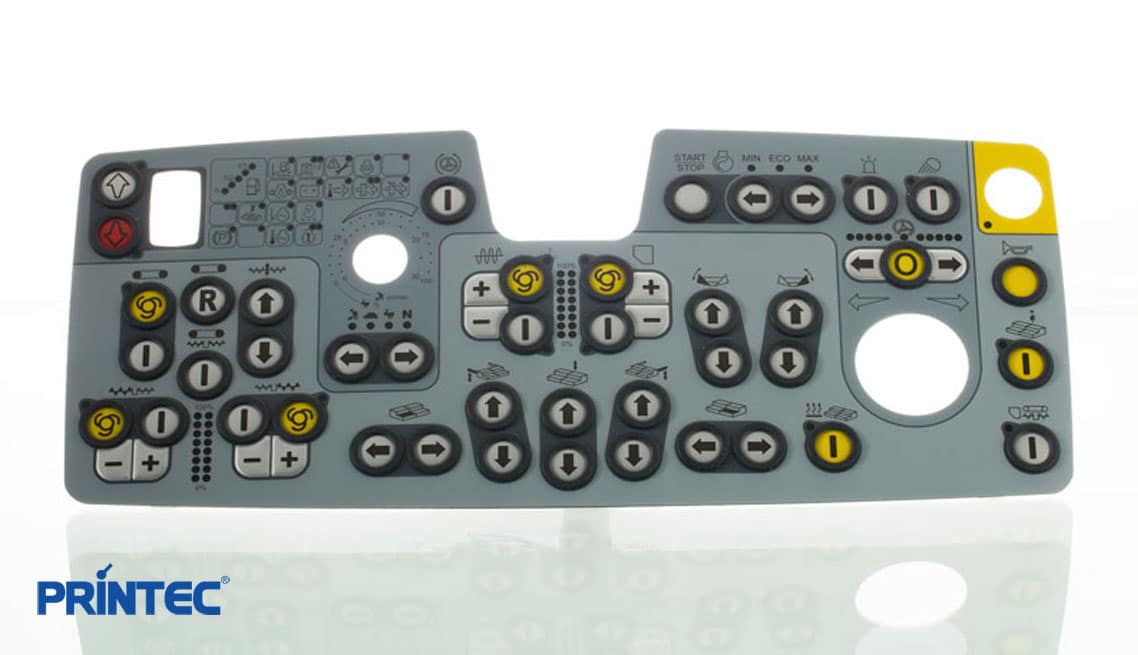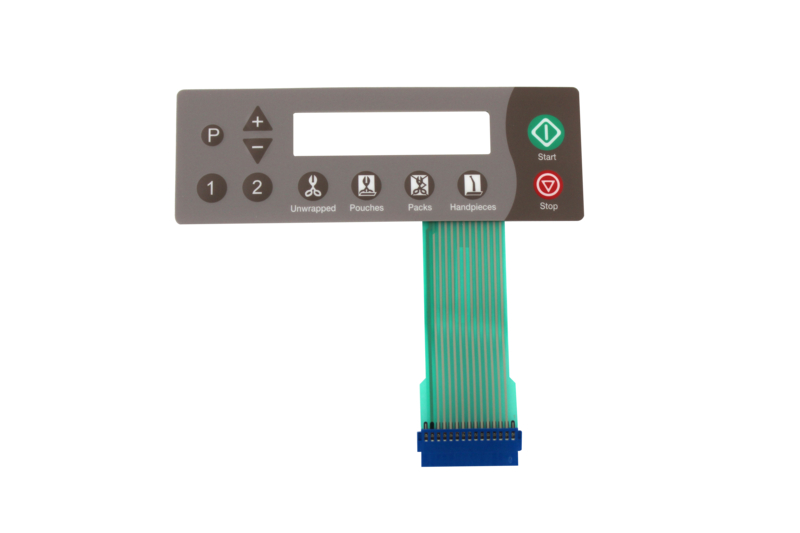Everything About Membrane Switch: Recognizing Its Layout and Capability
When you consider the control interfaces in modern devices, membrane layer buttons typically come to mind. These elements are more than simply buttons; they mix design and performance flawlessly. Understanding how they function and what makes them effective can alter your perspective on daily electronics. However, there are subtleties to their layout and performance that you may not know. Allow's discover what collections membrane switches apart from various other control systems.
What Are Membrane Layer Switches?

Membrane switches can additionally be tailored relating to shape, dimension, and graphics, permitting producers to develop unique user interfaces customized to certain items. Overall, membrane layer buttons play a considerable duty in enhancing customer experience across a wide range of applications.
Just How Membrane Layer Switches Job
When you press a trick on a membrane layer button, it activates an uncomplicated yet effective system. The leading layer, usually made from versatile material, lowers onto a conductive layer beneath it. This activity bridges the space in between conductive traces, finishing an electrical circuit. As quickly as the circuit closes, it sends out a signal to the tool's controller, which interprets your input.
You'll discover that the responsive responses differs based upon the switch style, providing either a soft click or an extra pronounced action. Once you release the key, the membrane layer returns to its original position, resuming the circuit and stopping the signal. This procedure occurs nearly instantly, ensuring a responsive individual experience.
Membrane layer buttons are prominent because of their toughness and resistance to dirt and moisture, making them perfect for various applications, from family home appliances to clinical gadgets. Comprehending this operation aids you value their extensive usage.
Key Elements of Membrane Layer Buttons
Comprehending the essential parts of membrane layer switches is fundamental for understanding their capability and style. At the core, you'll locate the visuals overlay, which offers the visual user interface for customers. Underneath that, there's a spacer layer that separates the circuit layers, guaranteeing that they don't make contact up until pressed. The circuit layer is where the magic occurs; it contains conductive traces that finish the circuit when you press the button. One more vital element is the adhesive backing, enabling the switch to follow surface areas firmly. Lastly, the protective layer shields against environmental factors and wear, prolonging the button's life-span. Each element plays a considerable duty in ensuring dependable performance and customer communication. By recognizing these elements, you'll gain insight into how membrane layer changes operate and their importance in different applications.
Materials Used in Membrane Layer Switch Over Layout
The performance and longevity of membrane switches over heavily rely on the materials utilized in their layout. You usually come across polyester and polycarbonate as key substratums due to their outstanding strength and flexibility. These materials stand up to scratches and chemicals, making them ideal for demanding environments.
The conductive layers often make use of silver or carbon, picked for their integrity and conductivity. membrane switch manufacturer. Silver offers remarkable efficiency, while carbon is an economical alternative. For the overlay, you may take into consideration a matte or glossy coating, relying on your visual demands and user experience
Adhesives play a necessary function too; they bond layers safely and assure durability. Make certain to choose adhesives that stand up to ecological aspects like temperature and humidity. Ultimately, do not neglect the value of a good printing strategy for graphics, as it boosts both functionality and visual charm. Choosing the right materials will guarantee your membrane button stands the examination of time.
Layout Considerations for Membrane Layer Buttons
While developing membrane buttons, it's important to take right into account different aspects that influence their capability and user experience. Begin by focusing on the design and switch dimension; make particular they're intuitive and simple to browse.
Confirm your design fits ecological factors, like moisture or temperature level variants, which can influence performance. By thoroughly thinking about these elements, you'll create a membrane layer switch that Our site improves functionality and fulfillment.
Applications of Membrane Layer Buttons
Membrane buttons are functional elements discovered in different applications, from industrial tools to customer electronic devices. Check Out Your URL You'll see their effect in equipments that call for long lasting user interfaces and in devices that gain from smooth styles. Understanding these applications assists you appreciate the capability and usefulness of membrane buttons in day-to-day technology.
Industrial Devices Usage
When you're looking to boost the performance of industrial tools, membrane layer buttons provide a dependable service that incorporates toughness with straightforward layout. These switches are excellent for harsh environments, supplying resistance to dust, moisture, and chemicals. You'll locate them in control panels for making machines, heating and cooling systems, and clinical gadgets, where accuracy and responsiveness are essential. Their low account implies they fit flawlessly right into various equipment, saving valuable space while keeping ease of use. With adjustable graphics and backlighting choices, you can create an intuitive user interface for operators, boosting effectiveness and security. Plus, their lengthy life expectancy minimizes upkeep prices, making them a wise financial investment for your industrial applications. Embrace membrane buttons to streamline your procedures and boost total performance.
Customer Electronic Devices Combination
In the domain of customer electronic devices, membrane layer buttons play a vital role in boosting individual communication and device performance. You'll locate them in devices like microwaves, remotes, and pc gaming consoles, supplying a seamless method to interact with technology. Their sleek layout permits simple integration into numerous products, making controls user-friendly and easy to use. With their ability to include graphics and backlighting, you can delight in a modern-day visual that enhances the tool's total look. Membrane layer switches likewise ensure sturdiness and resistance to dirt and wetness, expanding the life-span of your electronics. By choosing membrane switches, you enhance not simply the capability but likewise the style of your devices, making day-to-day communications smooth and satisfying.
Advantages and Negative Aspects of Membrane Layer Buttons
While membrane layer buttons Resources offer a variety of benefits, they likewise come with some disadvantages that you should consider. One substantial benefit is their compact design, making them excellent for space-constrained applications. They're likewise cost-effective, providing a long lasting solution with a reduced manufacturing cost. Furthermore, their smooth surface area is very easy to clean, improving health in atmospheres like health centers.

Membrane buttons can have a much shorter life-span compared to mechanical switches, specifically under hefty usage. They can likewise be less tactile, which might influence individual feedback during operation. Stabilizing these pros and cons will certainly aid you establish if membrane buttons are the right fit for your job.
Regularly Asked Concerns
Exactly How Long Do Membrane Switches Normally Last?
Membrane layer changes typically last in between 5 to ten years, depending on use and ecological conditions. You'll intend to assess elements like wear, exposure to dampness, and temperature level fluctuations to assess their long life effectively.
Can Membrane Layer Switches Be Personalized for Details Designs?
Yes, you can tailor membrane switches to fit particular layouts (membrane switch manufacturer). You'll have the liberty to choose shades, shapes, and layouts that match your job's requirements, guaranteeing they mix effortlessly with your general aesthetic
What Is the Cost Range for Membrane Change Production?
The cost range for membrane layer button manufacturing usually drops between $1 and $10 per system, depending upon factors like design intricacy, quantity, and products. You can obtain quotes from suppliers to find the most effective choice.

Are Membrane Layer Switches Over Water Resistant or Resistant?
Membrane layer switches can be created to be waterproof or immune, depending upon products made use of and building and construction approaches. If you require them for wet environments, guarantee you define those demands during the style process.
How Do Membrane Switches Over Contrast to Traditional Switches?
Membrane layer buttons are typically thinner and much more adaptable than conventional switches, using a smooth style. They're frequently easier to clean and integrate, but might not provide the tactile feedback you're utilized to with mechanical choices.
Final thought
